
|
 Midgley
of Cawthorne
Midgley
of Cawthorne 
|
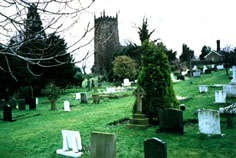 Some Historical Aspects for
Cawthorne and district:
Some Historical Aspects for
Cawthorne and district:
Cawthorne in South Yorkshire was originally called Caltorne in the Domesday Book of 1086(12) an O.E. meaning for "cold thorn-tree", that is an exposed place probably with thorns abundant. There was also a farmstead here called "Milnestede" the homestead of the Milnes family. Cawthorne was occupied by an Anglian Thane called Ailric. Ailric’s son was Swein (hence Hoyland-Swaine a village close by) Swein’s son was Adam Fitz-Swein. The Fitz prefix indicating that Adam had perhaps married into Norman-French lines and was considered of the illegitimate line to the Swein family. The village of Hoyland-Swaine was called Holande in the Domesday book in 1086 and by 1266 referred to as Holands Swayn. The manorial affix is taken from possession in the 1100’s by Swein [O. Scandinavian Sveinn.] (36)
In 1066 William I confiscated lands held by Edwin Earl of Mercia and Morcar,
Earl of Northumbria and all their supporters. In 1069 William
I laid waste all the lands between the Humber and the Tees (“Harrying
of the North”). By 1086 the Domesday book was being used to value every
manor in the country.

|
The Norman family the Bosvilles (Boswells) later
replaced the land ownership at Cawthorne. Then over the years
by a series of sales it came into the hands of the Spencers and Spencer-Stanhopes.
See History
of Cawthorne
THE MANOR HOUSE
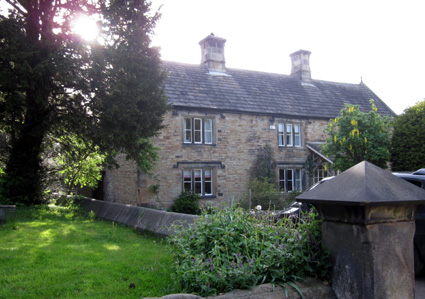 The original site of the Cawthorne Anglian
wooden manor house is on the north
side and very near to the church. (18). This was probably
replaced during the Tudor period and again in the 1870’s. In 1872 Mr. Stanhope
acquired
this house. In the 1880's Mr. Beaumont (Wentworth Canning
Blackett Beaumont) still retained lordship of the manor, he also still
owned Cinder Hill, the site of an iron forge, Low Mill Farm and
Cawthorne Park to the north (18) The Beaumonts were married into
the Wentworths and other families of West Bretton Hall. The Beaumonts
have links to the present British royal family viz:
The original site of the Cawthorne Anglian
wooden manor house is on the north
side and very near to the church. (18). This was probably
replaced during the Tudor period and again in the 1870’s. In 1872 Mr. Stanhope
acquired
this house. In the 1880's Mr. Beaumont (Wentworth Canning
Blackett Beaumont) still retained lordship of the manor, he also still
owned Cinder Hill, the site of an iron forge, Low Mill Farm and
Cawthorne Park to the north (18) The Beaumonts were married into
the Wentworths and other families of West Bretton Hall. The Beaumonts
have links to the present British royal family viz:
William Beaumont of the Oaks d. 1713>George Beaumont of Chapelthorpe + Gertrude Bagshaw> Jane Beaumont + Abel Smith I of East Stoke>Abel Smith II + Mary Bird> George Smith of Selsdon + Frances Moseley*>Oswald Smith of Blendon Hall, Kent + Henrietta Hodgson>Frances Dora Smith +Claude I Bowes-Lyon> Claude II Bowes-Lyon>Elizabeth Bowes-Lyon [late Queen mother] + Prince Albert Frederick Arthur George Windsor, d. 1952>Queen Elizabeth II. * Sister of Sir Oswald Moseley 2nd baronet great grandfather of Sir Oswald Mosley 6th baronet the renowned 'blackshirt'.
< The Cawthorne manor house in 2011.
![]() THE 1379 POLL TAX
THE 1379 POLL TAX
This tax on each adult provides the names of persons residing in each vill or township with the tax amount that was to be levied . In some instances their occupation was listed particularly when they were to be levied more than the nominal 4d. For Cawthorne the names are as follows:
 |
 |
Some local names that seem to have survived until more recent times are evident such as Moakson [Moxon], Milner [Milnes], Charlesworth, Hunter, Hepworth and Moseley.
THE CHURCH
During the Anglian period of occupation Cawthorne like many other Christian English settlements was associated with a stone cross. This cross acted as a central point around which local families gathered for prayerful meetings under the guidance of itinerant preachers. The base of the original Anglian cross can be seen in the present churchyard with the original head of the Anglian cross itself built into the church wall.
 |
| The head of the Anglian cross symbolically built into an early part of the Cawthorne church wall. |
 |
 |
| The engraved Anglian stone cross base |
![Window from All Saint's Church Faith [Fides] overcoming the folly of the world.](fides.gif) Also within the church is the original
Anglian font, a deep square-cut stone structure with the remains of carving on
the exterior..
Also within the church is the original
Anglian font, a deep square-cut stone structure with the remains of carving on
the exterior..


Fidelity Cawthorne Church font Cawthorne Church tower
A road connecting “Halifacks” and Wakefield called the “Magna Via” connected the two regions in medieval times and possibly Anglian times as packhorse routes. They both formed manors within the manor of Wakefield. There was also a packhorse route that ran from Cheshire to Penistone through Cawthorne to Wakefield. In 1554 Cawthorne was granted a 40 year licence to sell woollen cloth by the “good Waterhouse family of Halifax”(12). Dewsbury at the midpoint became an important woollen town. The area to the S.W. of Wakefield was prevented from developing by the Wakefield Guilds, with the collusion of local land owners.
BALLAD CONNECTIONS
The cryptic figure Robin Hood of ballad fame frequented the region that was densely forested prior to the iron industry. There is evidence that the historical character representing this ballad hero had a connection with Cawthorne that can be substantiated by primary evidence. References exist in local place names, his supposed gravesite at Kirklees near Mirfield and the existence of the so-called Little John’s thigh bone and Little John's bow formerly at Cannon Hall, Cawthorne give quasi-evidence for his second in command's presence.
"CANNON-HALL,Cawthorne (which was the seat of John Spencer Stanhope) anciently pronounced Camel-Hull, is rendered famous by being the retreat of Wm. Lockwood, of Lockwood, after the battle at Eland,with the Elanders, in the reign of Edward III. In this house, Lockwood commenced an amour with a young woman of loose principles, who betrayed him into the hands of his enemies. --Watson. In the library, which contained a valuable collection of books, among other curiosities, was the bow of Little John, the famous outlaw and companion of Robin Hood. It was brought many years ago from Hathersage, in Derbyshire, an estate formerly belonging to the Spencer family, where Little John was buried. The bow bears the name of Colonel Naylor, 1715, who is said to have been the last man who bent it. It is of Yew, and though the two ends, where the horns were affixed, are broken,it still measures above six feet." --Watson. --Neale (37)
Besides Alan-a-dale, Little John and Friar Tuck there was also a
member of the band called Much, the miller's son, in later
ballads phonetically referred to as “Midge”.
'Robin of Locksley' was probably active during the early 1300’s
during the reigns of Edward II and III. References
in King Edward II's accounts refer to a Robert Hood, where payments were
made for his services. See notes
on Robin Hood
PARISH CHURCH REGISTERS
From 1535 the destruction of the monasteries began and by 1538 the Vicar-General, Thomas Cromwell, had issued orders to each parish church to keep records of baptisms, marriages and burials (called a register) (12,p105) By 1661 the word ‘baptized’ was becoming the usual term in the Cawthorne church register rather than “borne” (12, p110). Other records can be found in Poll Tax lists, census records and The Domesday Book.
For a list of BDM's I have a microfiche for the parish church records of
Cawthorne that lists all those in the Cawthorne Parish Church register. Contact
if you need a look-up.
The Spencer and subsequently, Spencer Stanhope families dominated the land ownership and tenancies in the district and left a strong legacy upon the life of the village. See Spencer-Stanhopes.
| 1801 - 10 Mar 1811 - 27 May 1821 - 28 May 1831 - 30 May 1841 - 6 Jun 1851 - 30 Mar 1861 - 7 Apr 1871 - 2 Apr 1881 - 3 Apr 1891 - 5 Apr 1901 - 31 Mar 1911 - 2 Apr 1921 - 19 Jun* 1931 - 26 Apr 1941 1951 1961 1971 1981 1991. |
[*those in bold type not yet available,100 years has to elapse before census's are released]
Some parish churches began to keep a record of births deaths and marriages
in 1538. In 1665 the word “christening’ enters the Cawthorne register,
seldom is the name of both parents given (12, p110). In 1774 occupations
start to be given in the Cawthorne church register (12,p110)
James Schaw 1488^-1528==== LADY CHRISTINA BRUCE (GATEWAY ANCESTOR) 1470-1532
Lord Treasurer of Scotland 4x gt. granddaughter of Robert II Bruce and 6x gt. granddaughter of Robert I Bruce,
king of Scotland
|
| * Note: This can be disputed.. ^ Birth dates only 8 years apart.
James Gilbert
Shaw1480^-1528===Elizabeth
?===Richard Midgley of Halifax 1495-1555
| |
Agnes Schaye (Shaw) 1519-1585=========William Midgley of Halifax 1515-1578
|
Sybil Furniss====John Midgley of Halifax 1549-1650
|
Elizabeth Beane====William Midgley of Halifax and Bingley 1576-1636
|
Walter Midgley of Bingley 1601-1680===Ann Illingworth
|
John Gaulter (Walter) Midgley of Bingley 1643-1716=== Isabella Ambler
|
John Midgley of Keighley 1674-1738===Ann Holmes
|
Elizabeth Fielder = = 1732== William Midgley of Brayton, b: 1716, Leeds, d. 1759
- brother of John a predecessor of Midgley
of Hainworth
|
Mary Wilson ====William Midgley b: abt. 1736 of Burn, Brayton and Thorpe
Willoughby
|
Susannah Cheesbrough === Joseph Midgley b:1771 Hambleton
Ch 15th October 1771 Brayton
|
Sarah Peace === William Walter Midgley
Ch: 3rd Nov. 1808 Normanton
|
Elizabeth Hill=== Thomas Midgley
Ch: 27th Aug.1845 Cawthorne
|
Lavinia Milnes === William Midgley
b: Easter Day 1884 Cawthorne
|
John Patrick Midgley====Eunice Evelyn Bath
b:23rd July 1919 Cawthorne
William Walter Midgley
Son of Joseph Midgley of Normanton and Hambleton. See
Midgley of Normanton.
Christened 3/11/1808 at Normanton (6) . The eldest male in the
family. A farmer later at Cawthorne (Cawthorne register,Wakefield
Archives)
Related Cawthorne Families from the 1881 census
The last two children Thomas and Susannah were born here. Later Jowett
House was the pigeon loft of the Stanhopes’ Cannon Hall Estate
and housed 600-700 pigeons (14). It may have been a family delicacy
and were commonly eaten. Normally the tradition in England was
that only the lord of the Manor could partake of the pigeons because
they ate the lord’s grain. William Walter Midgley looked after Lord
Stanhopes pigeons.
William Walter Midgley married Sarah Peace (Pease)
on 28th December 1829 at Dewsbury(6) when he was 21 years old.
In the Strays Index, William Midgley, farmer and Sarah Peace were
married by licence, where these survive they can be useful with additional
details they are mostly held at York as are wills (Borthwick Institute,
University of York). Today [2006] Jowett House is a working dairy
cattle property. Note: Jowett is a local family name but also found in
the Halifax area. See also “History of
Jowett House”.
In the IGI Peace is held under Pease. Pease
Grove is the family house next to Thimble Hall,
a Midgley residence after1918. See O.S. map of
the Midgley farmland, Cawthorne, 1850 with names added later This
connection between the Midgley’s and Cawthorne could have come
about as a result of William Waller being notified of the house
and property availability by a member of the Peace family.
Described on 19th October 1858 a “Mr. Midgley,
church warden (Jowitt House) issued tickets at 6 pence each for
tea for the opening of the new Girls’ School”(12,p156).
Later in 1918 the Midgley family (14) under Thomas
and Elizabeth moved to Thimble Hall(5) in Tivy Dale
See Midgley
Gedcom download page

The Cawthorne Cross on the original site of the village maypole |
![]()
Also living at Cow Heys at the time of the 1881 census was Mary Ann's mother, Eliza Wilkinson, a widow aged 95 born 1786 at Farnham, Surrey.
The family resided in a farmhouse on Thorpe Hill Farm run by Benjamin
Scarth who was a farmer with 123 acres. Thorpe Hall had a bailiff and a coachman
in employment. There were two other farm labourers on the estate(44).
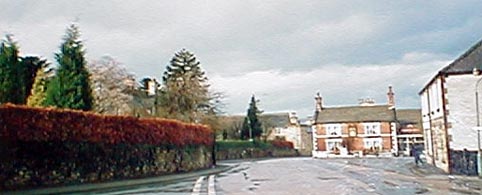
|

Photograph
circa 1909-10 Thimble Hall, Cawthorne.
Back:
Ethel, Garnett & Sarah (Sibbie) Midgley.
Front: Thomas Midgley, Elizabeth Midgley (nee Hill relative of
Sir Rowland
Hill)
The 1881 census showed Thomas the head of the household at “Jowet House”
aged 35.
Elizabeth his wife aged 32, Rowland Hill Midgley
8 years old and at school, Thomas Bernard 6 years old and at
school, Herbert 4 years old, Sarah 2 years old. All the children
are shown as being born in Cawthorne. At this time. Joseph Hill (Elizabeth’s
father) was resident at “Jowet” House aged 71 years, he was formerly
a farmer of Whitwell, Derbyshire.Also present were Sarah Hill (sister
to Elizabeth) unmarried aged 20 years and an indoor farm servant,
John Fish a farmer's boy, aged 16 years (20)(21)(44)

In 1891 the census showed that the residents of ‘Jowit House” were Thomas
46 years old, Elizabeth, 43 years old Rowland Hill Midgley
farmer’s son, unmarried 18 years, Herbert, farmer’s son, unmarried
aged 14 years, Sarah aged 12 at school, Reginald Waller Midgley,
son aged 9 at school, William Midgley son aged
7 at school, Garnett son aged 4 at school, Annie Ethel, daughter
aged 2.
Sarah Hill Elizabeth’s sister was still resident
at Jowett House unmarried aged 30 (20)(21)
Later Thomas became a Board of Health inspector for the district based on Penistone and undertook his rounds on a horse(14)
In 1832 there had been a great concern regarding the outbreak of cholera in Britain. A Board of Health was established in this year (18,p61). By March 1896 the drainage scheme for Tivydale had been carried out (19,p150)
A prominent churchman at Cawthorne: “1882 Mr. T. (Thomas) Midgley and Mr. C. (Charles) Wemyss, sidesmen and Mr. C. Wemyss observer for the poor (Barnby Green)”(12)
In 1918 there was a Spanish influenza epidemic (18) Thomas died
from the effects of the 'flu'(28)
List of sale of equipment from Thimble Hall after Bernard died:
| Sold by Arthur E. Wilby & Son at 1.30pm Friday 18th April 1947 |
| All values in pounds, shillings and pence (5) |
| Boxer | 73.10.3 |
| Cows | 32.2.0 |
| Calves | 26.0.0 |
| 4 steers | 25.0.0 |
| 3 steers | 23.0.0 |
| 3 heifers | 55.0.0 |
| cart | 20.0.0 |
| Wagon | 20.0.0 |
| rake | 10.0.0 |
| hen house | 20.0.0 |
| poultry | 35.0.0 |
| chicken house | 10.0.0 |
| Dobbin | 12.0.0 |
| Turner | 13.0.0 |
| ?Mucking | 6.10.0 |
Thimble Hall was the Midgley farm until 1952 when Bernard died (5).
Tom Morgan writes:
| SERRE
"This was another of the nine fortified villages
which were part of the objectives planned to be reached and
taken on 1st. July, 1916. Serre was a significant target on that
day because from their trenches in front of the village, the Germans
had a high view over a wide area of No-Man's Land, including the
part which would be crossed slightly to the South, in the attack
on Beaumont-Hamel and Hawthorn Ridge. To the North, there was a stretch
of the front about a mile long, in which no attack was to be launched,
although the men holding the trenches there had carried out patrols,
cut conspicuous gaps in their wire, and done all they could to convince
the Germans that whatever was being prepared for in the rest of the battle
area was being prepared for here, as well. On the morning of the attack,
men in these trenches were detailed to create a smoke barrage across No-Man's
Land to try to conceal the fact that nothing was happening there, for
as long as possible, so as to draw German artillery fire which might otherwise
have been directed at the attackers around Serre, to the South, and Gommecourt,
to the North, where a full-scale diversionary attack was being launched
to draw fire and resources even more. In the event, the smoke failed,
as the wind was blowing in the wrong direction, but even if the wind had
been more helpful, the Germans in the area would not have been confused
for long but, hopefully, for just long enough. The Plan, of course, meant
that the Germans had to be fooled only for a few minutes - the time it took
for the Battalions gathered around Serre to walk across No-Man's Land and
occupy the smashed German trenches. Then the benefit of observation would
be with the British. They were hard workers and they became Good Soldiers. However, in the eyes of many senior officers, they were not Real Soldiers, and this would be their first battle. The Commander of Fourth Army, Sir Henry Rawlinson, may have been thinking of the inexperience of many of the battalions under his command when he planned his attack. He placed great faith in the power of artillery to do the job of actually killing or subduing the Germans. Following the pounding bombardment, there would be little for his quickly-trained and inexperienced Pals to do beyond taking the German positions and holding on until more experienced military minds were able to direct them as to what to do next. The orderly, parade-ground march across No-Man's Land, five yards between each man, rifles to be held at the high port, with following lines of men to follow the bombardment as it moved from line to line, was part of this simple plan. The Accrington Pals, the Barnsley Pals, the Bradford Pals, the Durham Pals, the Leeds Pals and the more formally known Sheffield City Battalion rehearsed and believed. These were trusting, obedient men. They were also intelligent men, but this initiative was not really required by the battle plan for this area. They would advance and accomplish as one communal force - in keeping with the history of their recruitment. A nice touch. From Auchonvillers, a road runs North. After about
a mile, one reaches a crossroad. Straight on is Hebuterne. The
road to the right is the Serre Road. Driving along it, towards
Serre, one can see, off to the right, the trees of the Newfoundland
Memorial Park and Hawthorn Ridge Mine crater. I found it difficult
to keep my eyes off these landmarks. The road, which had been quite
straight for a long time, swung to the right and then to the left. Time
to look ahead. And there, to the right of the road, I saw the huge
Serre Road Number 2 British Cemetery, the largest on the Somme.
The cemetery today is immaculately-kept. When I was there, gardeners were laying new turf between some of the rows of graves, in preparation for the summer visitors. This cemetery receives many, but even the smaller and more isolated ones like Frankfurt Trench on the Redan Ridge nearby, are maintained with the same breathtaking devotion. From the cemetery, one can look across fields towards the village of Serre. The village is actually out of sight at this point, but one can see the nature of the open land towards it, which the British had to cross. An indication of the size of the tragedy which took place in this area is visible however - in the shape of another two big cemeteries - Serre Road Number 1 (2,412 graves, almost three-quarters of them unidentified) with, next to it, the French National Cemetery. This cemetery , strangely enough, is also the work of the British. By the time the last search for British bodies in these fields was made, in the 1930s, the bodies of 817 French soldiers had also been found. These men fell in the days when this had been a French sector of the front. As French bodies were found, the British buried them in a cemetery of their own. Eventually, the completed cemetery was handed over to the French Government. Opposite these two side-by-side cemeteries is a track, leading to the Redan Ridge cemeteries. Those who have read Part 1 of this diary might remember my description of my walk up the Sunken Lane near Beaumont Hamel, to the cemeteries on the sites of Frankfurt Trench and Munich Trench. I returned home the way I had come on that occasion, but if I had carried on along the site of the German front line, I would have arrived in about ten minutes at the Serre Road, by this track. The track leading from Serre Road is the "official route" to the Redan Ridge cemeteries and at the junction with the road stands a multiple signpost, pointing the way to them. At the foot of the signpost were about half a dozen unexploded shells. These are still being ploughed up, eighty years after they were fired. The farmers always leave these relics next to a cemetery signpost. I suppose that this is where the collection and disposal teams look for them. In all guidebooks to the Somme, the reader is warned of the danger of meddling with these shells. Presumably the farmers themselves don't read these guidebooks. All the shells I saw awaiting collection, apart from one huge monster, had been attacked with hammer and chisel and the valuable copper driving bands removed. the dust referred to by so many men who served here that summer. 
(The farmer was harrowing his field. This is where all the dust was coming from. He wore a dust-protector over his face as he drove his tractor. He seemed to be doing this all the time, using powerful lights on an overhead bar over the cab when it got dark. By the last visit, we had waved to each other sufficiently often for us to become acquaintances. So, as he was working near to the road, I asked him if I might inspect his pile of scrap. Every farmer in this area has such a pile, brought in from the fields. This is how I came to bring home a complete British screw-picket, used to support barbed wire.) The track peters out at the top, and I parked next to the first of three small cemeteries which mark the halfway point across the old No-Man's Land in this area. This is Serre Road Number 3 Cemetery. A little further away is Queen's Cemetery and beyond that is Luke Copse Cemetery. These cemeteries mark the No-Man's Land of the Northern limits of the main British attack front on 1st July, 1916. Opposite Queen's Cemetery is the Sheffield Memorial Park. In 1916, there were four small copses here, marked on British maps as Matthew, Mark, Luke and John. They now form one continuous line of trees, and this is the boundary of the Park. Behind the Park area, the land falls away into a little valley, where a light railway ran, and on this spot, next to the biggest shell-hole I have ever seen anywhere on the Western Front, is Railway Hollow Cemetery, which was started, like so many cemeteries in this area, in 1917. It contains the graves of many Pals who fell on 1st July. At the edge of the Park, facing the German positions, a shallow depression snakes along the line of the perimeter fence. This is trench from which the Accrington Pals attacked. The Germans were about 250 yards away. Hardly any of the Pals reached the German lines. The three cemeteries in the old No-Man's Land tell their own story. These fields were the anvil on which the metal of the Pals was tested. The metal may have been beaten, and rendered shapeless and unrecognisable, but as any blacksmith will tell you, its purity and worth were not destroyed, only enhanced. Here, about ten minutes before zero-hour, the Accrington
Pals climbed out of their trenches, passed through the gaps
in their wire and lay down in No-Man's Land until all the leading
"waves" were in position. At 7.30 a.m. the barrage stopped,
the whistles blew and the Pals stood up. Then the steady walk forward
began. This was also the land of the deep German dug-outs. As soon
as the barrage lifted, the Germans were quick to respond, manning
their parapets and staring in disbelief at the slow, regular advance
of the Pals. The first shots began to ring out and other German defenders
joined in. They couldn't believe that the British were just walking
towards them, wave after wave. One German soldier in this place, facing
the Accrington Pals, later wrote to Martin Middlebrook, who was collecting
information for his book, "The First Day on the Somme." "If only
they had run," said the German, "they would have overwhelmed us."
The British barrage, which could have relieved the pressure on them, was now dropping its shells far into the rear of Serre, according to a previously-planned timetable which could not be changed. It had all gone horribly wrong. Their leaders had been mistaken, but had not allowed for this possibility. Those who survived, emerged as different men. They and their friends had offered their all, trustingly, and they felt, right or wrong, that this trust had been squandered. The belief that their leaders knew best and knew all, this Victorian belief which had enabled them to entrust their very lives to the will and care of others, was as dead as the 5,415 men who lay out in the No-Man's Land of this Northern Sector. From now on, men would begin to think of themselves first, a little more often, and would want to have more of a say in the control of their own future. I firmly believe, in spite of what the calendar may
say, that the 20th Century began in these fields, around Serre, on 1st July,
1916. "
. |
[Both phases of the Battles of the Somme 1916]
1917
The Battle of Messines (Belgium) where soon after William was injured in the leg during action on the Somme.
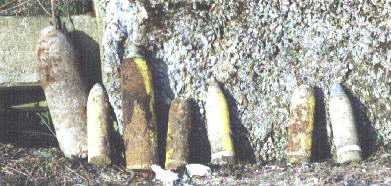
Shells left under signposts today by farmers
at Serre ready for collection.
He received a letter of commendation from his commanding
officer, Major E. Moore, stating that he was “thoroughly reliable
and trustworthy and that his name had been put forward for special
mention in connection with gallant conduct and coolness under
fire on many occasions, particularly during the time that the 41st
Division was in action in the Somme on September 15th and October
7th 1916”
|
“A standard sight on the first day of the battle was the few British troops who had somehow crossed to no-man’s land alive standing puzzled in front of the uncut German wire to be shot down in their turn. When the first day of the Battle of the Somme was over, it would be found that of the 100,0000 men who had attacked, 20,000 lay dead between the lines. It was the greatest loss of life in British military history. On the Somme Haigh had sent the flower of British youth to death or mutilation”(40). |
William received a commendation from Major General Sydney Lawford Commander
of the 41st Division,
the father of the actor Peter Lawford, “for good conduct and exemplary behaviour
under fire", May 1916 to September 1916. William served as a
Lt. Corporal one year 313 days with the colours and one year
and eight days.
At the 1st of October 1917 he was described
in his war papers as aged 33 years and 9 months was 5’11 1/2” tall with blue eyes, fair hair.
He was on Active Service 2nd May 1916 to 9th
May 1917 with the 233rd Field Company, [Ripon] Royal Engineers,
B.E.F., France.
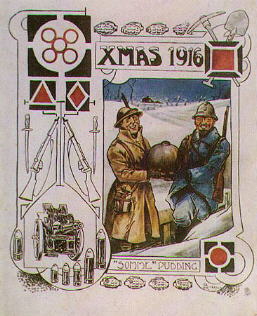 William's final discharge came on 1st October
1917 due to being hit above the right knee by shell fire in May
1917.
William's final discharge came on 1st October
1917 due to being hit above the right knee by shell fire in May
1917.
He was hit when their group pulled back for
48 hours rest, they were showering in the bath-house when a
shell landed killing many of his companions and injuring
William. After injury William was hospitalised at No.8
Canadian Casualty Clearing Station from 4th May 1917. After recuperation
William enrolled as war munition volunteer on 20th April 1918.
He became a member of the District War Pensions
Committtee, resigning from this in January 1937. In 1924 William moved with his family to Shepley
to an address on Marsh Lane. William bought the house and also
rented the house next door. William worked as a coachwork builder
for Rolls-Royce.(3) The family stayed here until 1936(5). A photograph of the two houses occurs in the
“Shepley A village History 1890-1990 on page 23 and is incorrectly
labelled as” Station Road 1859”(5).
J.P.M. believes that the boy in the photograph
could be himself(5).
On page 43 of the same book Mr. W. Midgley is
shown as being the chief marshall of the Grand Carnival Procession.
William died in 1955.
In the 1964 the B & W film 'King and
Country' portrayed a court martial scene
in the WWI trenches. James Villiers played the part of “Captain
Midgley” for the prosecution, which appears 5th or 6th on the
credits.
The Great War cost 41st Division 32,158 men killed, wounded or missing. There is a memorial to the 41st Division in the village of Flers, Somme. The village was captured by units of the Division on 15 September 1916.
Map 1 of Cawthorne
showing residences, footpaths etc.
Map 2 of Cawthorne
showing residences, footpaths etc..
 |
|
The Cawthorne Cricket Club 193649
Back Row: Edwin Lisle | Harry Fish | Charlie Hopton | Jack Fish | Jack Buckley | Fred Buckley | Edwin Fish Front Row: Raymond Fish | Clive A. Buckley | Noel F. Moxon | Fred Lisle | Ronnie Midgley | Colin McNaught |
John Patrick
Midgley
Eldest son of William Midgley and Sarah nee
Milnes of Cawthorne. Born 23rd July 1919 in the former
Toll House, Cawthorne. Whilst in the R.N. in WW2, saw action
on the Russian convoys to Archangel and after the war (1947-9)
action on H.M.S. London during the Chinese Revolution in the Yangtze
Incident when H.M.S. Amethyst was trapped on the Yangtze
river and the London tried to help rescue her. Died 12th June
1999,Oakville N.S.W. Australia.
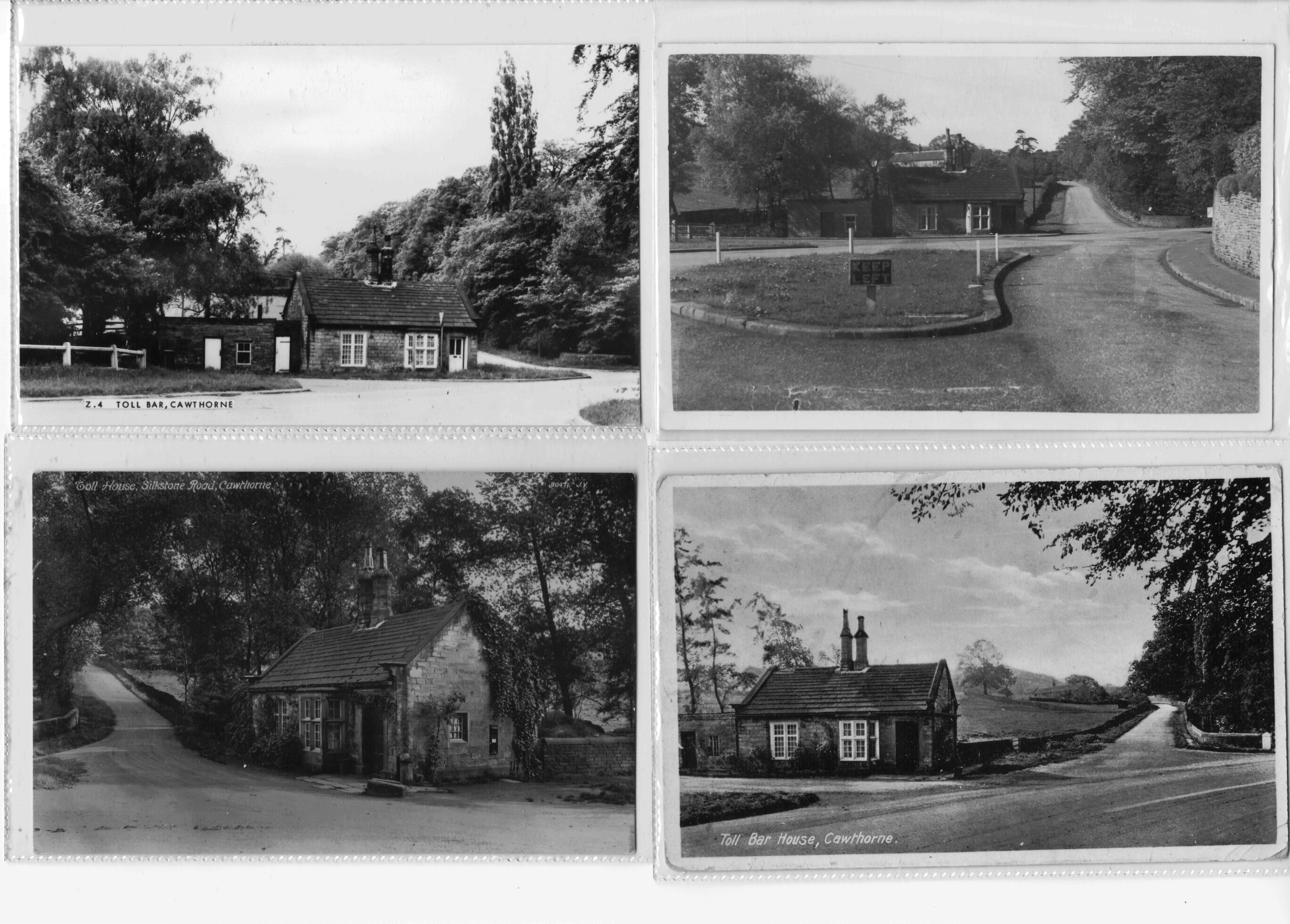 |
|
Toll Bar House, Cawthorne. In the background to the lower right postcard
can be seen Thimble Hall,
a Midgley residence after 1918.
|
Paul Hesketh's
parents of Barnsley knew Walter when Walter lived in Thorpe Hesley
near Rotherham. Walter was a member of Thorpe Hope Methodist Church.and
he sang at their Eastwood Methodist Church on several occasions.
References/Sources:
1. Letter of war Service by commanding officer for William Midgley.
2. “History Today” Vol 40 Dec 1990
3. pers comm. Patrick and Eunice Midgley.
4. pers. comm. Mary Richardson (nee Seeley) daughter of Annie Milnes Jan. 1984.
5. pers comm. John Patrick Midgley son of Lavinia Milnes and William Midgley.
6. I.G.I. DO769 or DO768 Yorkshire.
7. Cawthorne Centenary Booklet (1980) Barry Jackson churchwarden.
8. pers. comm. Gillian McDougall nee Midgley of Springwood, N.S.W.
9. Letter to Sarah Wemyss from brother James C. Wemyss 28/6/1916
10. Letter from Anthony Hindley of Cawthorne containing pedigrees drawn up by Henry Milnes Walker(1989)
11. Letter from Charles Brian Midgley.
12. “History of Cawthorne” C.T. Pratt (1880)
13. Letters from Lt. Col. Charles Crossland (1983,1984)
14. Letter from the late Ronald T. Midgley (1982)
15. Letter from the late Roy Wemyss Milnes of Cawthorne.
16. Copy of Mildred Holroyd’s letter to Charles Crossland.
17. I.G.I. CO668 Northumberland (batch M109171, serial sheet 0594)
18. “Cawthorne 1790-1990, a South Yorkshire Village Remembers Its past”, Barry Jackson June 1990
19. Letter from Anthony Hindley March 1992
20.Letter from Audrey Town, 33, New Lane, Skelmanthorpe, July 1992
21. Census returns for 1881 (RG11/4611 Ed. 2, folio 30, p.20) and 1891 (RG12/) held at the Wakefield Local Studies Library and Barnsley Local Studies Library.
22. Taken from videotape made by Peter Arnold in Cawthorne late 1980’s
23 I.G.I. DO583 Yorkshire
24. English Parish Records, State Archives, Kingswood, Sydney, N.S.W.
25. Church of Latter Day saints (Mormons) I.G.I. Centre, Ryde, Sydney, N.S.W.
26. The Letterbag of Lady Spencer-Stanhope ed. by Anna Stirling pub. 1913
compiled
from The Cannon Hall Papers 1806-1873 2 volumes,
published by John Lane, London,
Bell & Cockburn, printers, Toronto 1913.
27. I.G.I. Ayrshire
28. Letter from Dyone Dodson (nee Midgley) 11th May 1993.
29. Organic Chemistry p.109 Morrison and Boyd.
30. Huddersfield Examiner article 1993.
31.”Country Eye” Geoffrey Young p.99
32. Biographical Encyclopaedia of Science Asimov pp930-1
33. Thomas Moules maps of old England printed 1930
34. Pedigree drawn up by solicitors for Ina Hepworth Estate in 1950’s
35. Letter from C.B. Midgley June 1995
36. Dictionary of English Place Names” A.D. Mills O.U.P. 1997
37. Internet resource: Cities & Towns of the West Riding
38. According to Jens Raunkjaer Graungaard, Parkvej 63, DK 4140 Borup, +45 57 52 2181 jensg@centrum.dk, https://www.danbbs.dk/~jensg/
39. Survey & Depth A. Barcan Griffin Press 1972.
40. The First World War, John Keegan, Hutchinson 1998.
41. E-mail communication with David Midgley of Tasmania.
42. Census 1851 for Wakefield district.
43. Census 1881 for Cawthorne, South Yorkshire.
44. Census 31st March 1881 for England.
45. Dictionary of English Place-Names, A.D. Mills, O.U.P.
48. Normanton Marriage Index 1813-1837 W&D FHS
49. From a postcard kindly provided by Chris Moxon. Chris has a strong interest in postcards of Cawthorne. If you have any he would be pleased to hear from you.
Tasker Trust Photographs - taken in the Barnsley - Cawthorne area.
© Tim Midgley 1998, revised 28th January 2024